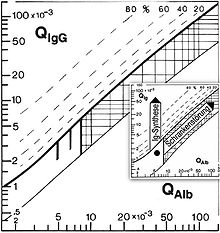Hansotto Reiber
Hansotto Reiber (born March 6, 1940 in Stuttgart ) is a German biochemist who has made a particular contribution to research into the nervous and aqueous humor . In addition, he worked on research into the neurobiological basis of memory.
Life
Reiber studied biochemistry at the University of Tübingen from 1964 to 1970 . In 1974 he was at the Technical University of Braunschweig on the model and enzyme system B-6 catalyzed α vitamin, β-elimination [alpha, beta-elimination] on theoretical fundamentals of enzyme kinetics doctorate . He then worked for four years as a research assistant at the Max Planck Institute for Experimental Medicine in Göttingen.
In 1978 he took over the management of the neurochemical laboratory at the University Clinic for Neurology in Göttingen and devoted himself mainly to liquor diagnostics , but also to the analysis of aqueous humor from the eye. In 1984 he completed his habilitation with the thesis Pathobiochemical processes in inflammatory, demyelinating diseases of the central nervous system and their detection in the cerebrospinal fluid . In 1988 he was appointed professor of neurochemistry at the Georg-August University in Göttingen .
Until his retirement in 2005, he carried out research in the field of liquor, with particular attention to inflammatory diseases of the nervous system in adults and children, as well as malignant and tropical neurological diseases. He is the (co-) editor of several books on liquor diagnostics and the author of numerous scientific publications.
The "Reiber diagram"
Developed by Reiber quotient chart is used to analyze the immunoglobulins in the cerebrospinal fluid (CSF) within the diagnosis of neurological diseases. In each case, quotients are formed from the concentrations of albumin and immunoglobulins in CSF and serum (Q IgG = IgG concentration in CSF / IgG concentration in serum and Q Alb = albumin concentration in CSF / albumin concentration in serum). The calculated values are entered in the Reiber scheme, which also includes a line that expresses the normal distribution in a healthy patient. If the current values of a patient are above the normal distribution on the left, it is an intrathecal immunoglobulin synthesis and thus an inflammation of the central nervous system (CNS). If both IgG and albumin concentrations rise in the CSF in the same ratio, there is a barrier disorder.
Web links
| personal data | |
|---|---|
| SURNAME | Reiber, Hansotto |
| BRIEF DESCRIPTION | German biochemist |
| DATE OF BIRTH | March 6, 1940 |
| PLACE OF BIRTH | Stuttgart |
